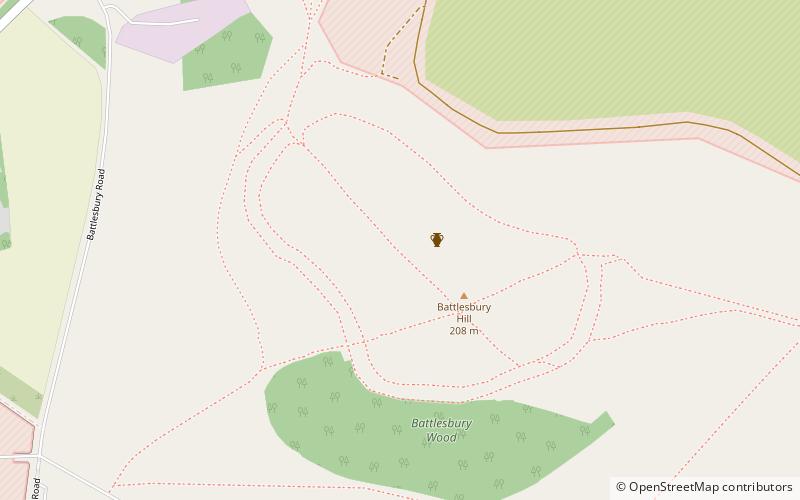Battlesbury Camp
#2805 among destinations in the United Kingdom


Facts and practical information
Battlesbury Camp is the site of an Iron Age bivallate hill fort on Battlesbury Hill near the town of Warminster in Wiltshire, South West England. Excavations and surveys at the site have uncovered various finds and archaeological evidence. ()
EnglandUnited Kingdom
Battlesbury Camp – popular in the area (distance from the attraction)
Nearby attractions include: Longleat Safari Park, Westbury White Horse, Warminster Town Park, Edington Priory.
 Zoo
ZooLongleat Safari Park, Warminster
130 min walk • Longleat Safari Park, a pioneering and captivating wildlife experience nestled in the heart of the English countryside in Warminster, stands as a premier attraction for animal lovers and adventure seekers alike. Opened in 1966, it was the first drive-through safari...
 Hill figure originally cut in the 1600s
Hill figure originally cut in the 1600sWestbury White Horse, Westbury
93 min walk • Westbury or Bratton White Horse is a hill figure on the escarpment of Salisbury Plain, approximately 1.5 mi east of Westbury in Wiltshire, England.
 City hall
City hallWarminster Town Park, Warminster
39 min walk • Warminster Town Hall is a former municipal building in the Market Place of Warminster, Wiltshire, England. The structure, which served as the headquarters of Warminster Urban District Council, is a Grade II listed building.
 Monastery, Church
Monastery, ChurchEdington Priory
130 min walk • Edington Priory in Wiltshire, England, was founded by William Edington, the bishop of Winchester, in 1351 in his home village of Edington, about 3+3⁄4 miles east of the town of Westbury. The priory church was consecrated in 1361 and continues in use as the parish church of Saint Mary, Saint Katharine and All Saints.
 Church
ChurchSt Denys' Church, Warminster
46 min walk • St Denys' Church is the parish church of the town of Warminster, Wiltshire, England, and is the town's oldest church. Begun in the 11th century, rebuilt in the 14th and restored in the 19th, it is a Grade II* listed building.
 Church
ChurchSt Giles' Church
115 min walk • St Giles' Church in the deserted village of Imber, Wiltshire, England, was built in the late 13th or early 14th century. It is recorded in the National Heritage List for England as a Grade I listed building, and is now a redundant church in the care of the Churches Conservation Trust.
 Natural attraction, Lake, Body of water
Natural attraction, Lake, Body of waterShearwater Lake
90 min walk • Shearwater is a man-made freshwater lake near Crockerton village, about 2 ¹⁄₄ miles southwest of the town of Warminster in Wiltshire, England. The lake is formed from a tributary of the River Wylye. It is within the Longleat Estate and is one of five lakes of various sizes.
 Concerts and shows, Theater
Concerts and shows, TheaterWarminster Athenaeum, Warminster
40 min walk • Warminster Athenaeum is a Victorian theatre in Warminster, Wiltshire, England, and a Grade II listed building. Built in Jacobean style in 1857/8 to designs by William Jervis Stent, it is held in trust on behalf of the residents of Warminster by a charitable trust and is Wiltshire’s oldest working theatre.
 Archaeological site
Archaeological siteBratton Castle
95 min walk • Bratton Castle is a bivallate Iron Age built hill fort on Bratton Down, at the western edge of the Salisbury Plain escarpment. The hill fort comprises two circuits of ditch and bank which together enclose a pentagonal area of 9.3 hectares.
 Forts and castles
Forts and castlesCley Hill
95 min walk • Cley Hill is a prominent hill to the west of Warminster in Wiltshire, England. Its summit has a commanding view of the Wiltshire / Somerset county boundary, at 244 metres elevation. The land is in Corsley parish and is owned by the National Trust.
 Church
ChurchSt. Mary's Church
83 min walk • St Mary's Church in Old Dilton, Wiltshire, England was built in the 14th century. It is recorded in the National Heritage List for England as a Grade I listed building, and is now a redundant church in the care of the Churches Conservation Trust. It was declared redundant on 26 April 1973, and was vested in the Trust on 6 September 1974.
